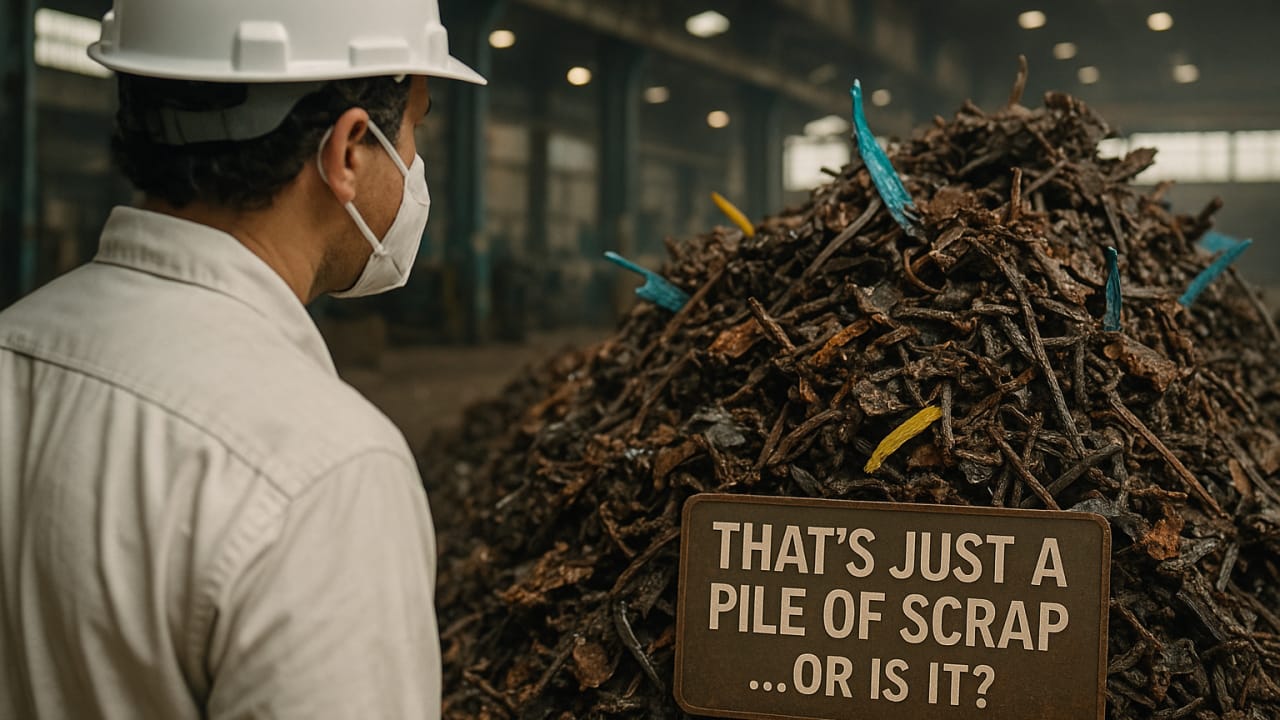That’s Just a Pile of Scrap… Or Is It?

byJayanth Bhat R
My personal awakening to this challenge came during my consulting days with manufacturing industries across the Indian subcontinent. I still vividly remember the moment—
It was 12 noon in Palakkad, on a pleasantly rainy day. The air was moist, and a cool breeze was drifting around, but despite the weather, I was profusely sweating beneath a heavy-duty mask, worn to protect myself from the harsh chemicals in the air.
In the middle of a bustling factory floor, I casually asked the production supervisor:
“What happens to all this scrap?”
He replied without hesitation: “We melt everything down and make our product.”
Curious, I probed further: “And what about all these plastic bits sticking out?”
He shrugged and said: “That? It's just a pile of scrap that melts and changes form. We can’t segregate everything… can we?”
The answer struck me. In that moment, I realized—
The plastics weren’t supposed to be part of the product.
But they were—not by design, but because complete segregation isn't always possible.
Until that point in my career, I had seen mountains of plastic scrap in every shop floor, warehouse, storage facility, and scrap yard I visited. I naively believed all of it was safely scrapped and would never see the light of day again.
That day, standing in the factory, I understood the painful truth: these plastics don’t just disappear. They only change form. And they continue to live on, in landfills, rivers, oceans, and even in the very air we breathe.
The Unseen Problem in Manufacturing: Single-Use Plastic Waste In today’s fast-paced industrial world, plastic packaging has become an inseparable part of manufacturing and supply chains. From protecting delicate components to ensuring safe transportation of goods, plastic packaging offers undeniable convenience, durability, and cost-efficiency. However, beneath this convenience lies a growing environmental crisis that is often overlooked—the enormous volume of plastic waste that is generated, used briefly, and discarded into an already overburdened planet.
The Ubiquity of Plastic in Industrial Packaging Industrial packaging is vastly different from consumer packaging. In manufacturing plants, plastics are used for:
- Component protection (films, foams, bubble wraps, plastic pouches)
- Moisture and corrosion prevention (VCI films, zip lock pouches)
- Safe handling and storage (plastic trays, stretch wraps, shrink films)
- Bulk transportation (plastic pallets, strapping, wrapping materials)
These plastics travel with products through the supply chain—from factory floors to warehouses, then to distributors, retailers, and end users. The sheer scale of this consumption across industries like automotive, electronics, pharmaceuticals, and machinery is staggering.
The Environmental Footprint The problem arises when these plastics, designed for single-use, end up in landfills, incinerators, or worse, in oceans and natural ecosystems.
- Every year, over 300 million tons of plastic are produced globally, and nearly half is for single-use purposes.
- Industrial packaging, while less visible to the public eye compared to consumer plastics, contributes significantly to this mountain of waste.
- These plastics can take anywhere from 500 to 1,000 years to degrade, releasing harmful microplastics and toxic chemicals into the environment.
Impact on Planet Earth
- Land Pollution: Vast amounts of industrial plastic waste clog landfills, where decomposition is virtually non-existent.
- Marine Pollution: Improperly disposed plastics find their way into rivers and oceans, affecting marine biodiversity.
- Carbon Footprint: The production and disposal of plastics are carbon-intensive processes, accelerating climate change.
- Human Health Risks: Microplastics are now found in the air we breathe, the water we drink, and the food we eat, posing significant health hazards.
A Step Towards Change: Compostable Packaging Solutions Recognizing this urgent issue, we at Phitons Bioengineering have taken a science-led approach to address the problem. Our focus is on creating sustainable alternatives to conventional plastic packaging, specifically tailored for industrial applications.
One such solution is Durapack—a compostable packaging material designed to replace single-use plastics in manufacturing and supply chains. Durapack delivers the performance and reliability of traditional single-use plastics, while significantly reducing environmental impact through responsible disposal. Moving Forward Together The challenge of single use plastic waste cannot be solved overnight, but it starts with awareness and the willingness to adopt better alternatives. As businesses and as individuals, we have the power to make choices that are not only good for the bottom line but also good for the planet.
It’s time we rethink the materials we use and take tangible steps toward a more sustainable future.
✅ If this message resonates with you, let’s start the conversation on how we can make packaging greener, one solution at a time.
#Sustainability #IndustrialPackaging #CompostablePackaging #CircularEconomy #Durapack #PlasticWaste

